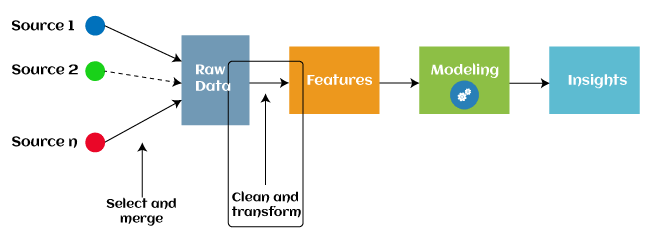Feature Engineering for Machine LearningFeature engineering is the pre-processing step of machine learning, which is used to transform raw data into features that can be used for creating a predictive model using Machine learning or statistical Modelling. Feature engineering in machine learning aims to improve the performance of models. In this topic, we will understand the details about feature engineering in Machine learning. But before going into details, let's first understand what features are? And What is the need for feature engineering? 
What is a feature?Generally, all machine learning algorithms take input data to generate the output. The input data remains in a tabular form consisting of rows (instances or observations) and columns (variable or attributes), and these attributes are often known as features. For example, an image is an instance in computer vision, but a line in the image could be the feature. Similarly, in NLP, a document can be an observation, and the word count could be the feature. So, we can say a feature is an attribute that impacts a problem or is useful for the problem. What is Feature Engineering?Feature engineering is the pre-processing step of machine learning, which extracts features from raw data. It helps to represent an underlying problem to predictive models in a better way, which as a result, improve the accuracy of the model for unseen data. The predictive model contains predictor variables and an outcome variable, and while the feature engineering process selects the most useful predictor variables for the model. 
Since 2016, automated feature engineering is also used in different machine learning software that helps in automatically extracting features from raw data. Feature engineering in ML contains mainly four processes: Feature Creation, Transformations, Feature Extraction, and Feature Selection. These processes are described as below:
Below are some benefits of using feature selection in machine learning:
Need for Feature Engineering in Machine LearningIn machine learning, the performance of the model depends on data pre-processing and data handling. But if we create a model without pre-processing or data handling, then it may not give good accuracy. Whereas, if we apply feature engineering on the same model, then the accuracy of the model is enhanced. Hence, feature engineering in machine learning improves the model's performance. Below are some points that explain the need for feature engineering:
Steps in Feature EngineeringThe steps of feature engineering may vary as per different data scientists and ML engineers. However, there are some common steps that are involved in most machine learning algorithms, and these steps are as follows:
Feature Engineering TechniquesSome of the popular feature engineering techniques include: 1. ImputationFeature engineering deals with inappropriate data, missing values, human interruption, general errors, insufficient data sources, etc. Missing values within the dataset highly affect the performance of the algorithm, and to deal with them "Imputation" technique is used. Imputation is responsible for handling irregularities within the dataset. For example, removing the missing values from the complete row or complete column by a huge percentage of missing values. But at the same time, to maintain the data size, it is required to impute the missing data, which can be done as:
2. Handling OutliersOutliers are the deviated values or data points that are observed too away from other data points in such a way that they badly affect the performance of the model. Outliers can be handled with this feature engineering technique. This technique first identifies the outliers and then remove them out. Standard deviation can be used to identify the outliers. For example, each value within a space has a definite to an average distance, but if a value is greater distant than a certain value, it can be considered as an outlier. Z-score can also be used to detect outliers. 3. Log transformLogarithm transformation or log transform is one of the commonly used mathematical techniques in machine learning. Log transform helps in handling the skewed data, and it makes the distribution more approximate to normal after transformation. It also reduces the effects of outliers on the data, as because of the normalization of magnitude differences, a model becomes much robust. Note: Log transformation is only applicable for the positive values; else, it will give an error. To avoid this, we can add 1 to the data before transformation, which ensures transformation to be positive.4. BinningIn machine learning, overfitting is one of the main issues that degrade the performance of the model and which occurs due to a greater number of parameters and noisy data. However, one of the popular techniques of feature engineering, "binning", can be used to normalize the noisy data. This process involves segmenting different features into bins. 5. Feature SplitAs the name suggests, feature split is the process of splitting features intimately into two or more parts and performing to make new features. This technique helps the algorithms to better understand and learn the patterns in the dataset. The feature splitting process enables the new features to be clustered and binned, which results in extracting useful information and improving the performance of the data models. 6. One hot encodingOne hot encoding is the popular encoding technique in machine learning. It is a technique that converts the categorical data in a form so that they can be easily understood by machine learning algorithms and hence can make a good prediction. It enables group the of categorical data without losing any information. ConclusionIn this topic, we have explained a detailed description of feature engineering in machine learning, working of feature engineering, techniques, etc. Although feature engineering helps in increasing the accuracy and performance of the model, there are also other methods that can increase prediction accuracy. Moreover, from the above-given techniques, there are many more available techniques of feature engineering, but we have mentioned the most commonly used techniques.
Next TopicTop 10 Machine Learning Courses in 2021
|
 For Videos Join Our Youtube Channel: Join Now
For Videos Join Our Youtube Channel: Join Now
Feedback
- Send your Feedback to [email protected]
Help Others, Please Share










